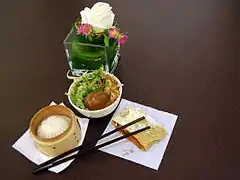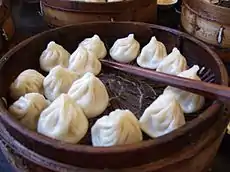Baozi
Baozi (Chinese: ![]() 包子), or bao, is a type of yeast-leavened filled bun[1] in various Chinese cuisines. There are many variations in fillings (meat or vegetarian) and preparations, though the buns are most often steamed. They are a variation of mantou from Northern China.
包子), or bao, is a type of yeast-leavened filled bun[1] in various Chinese cuisines. There are many variations in fillings (meat or vegetarian) and preparations, though the buns are most often steamed. They are a variation of mantou from Northern China.
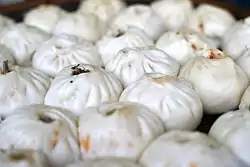 Meat-filled baozi for sale in a market | |
| Alternative names | Bao, humbow, pau |
|---|---|
| Type | Filled steamed bread |
| Place of origin | North China |
| Region or state | China, Hong Kong, Taiwan, East Asia, Chinatown in the world |
| Variations | Dabao, xiaobao |
| Baozi | |||||||||||||||||
|---|---|---|---|---|---|---|---|---|---|---|---|---|---|---|---|---|---|
"Baozi" in Chinese characters | |||||||||||||||||
| Chinese | 包子 | ||||||||||||||||
| |||||||||||||||||
Two types are found in most parts of China and Indonesia: Dàbāo (大包, "big bun"), measuring about 10 centimetres (3.9 in) across, served individually, and usually purchased for take-away. The other type, Xiǎobāo (小包, "small bun"), measure approximately 5 centimetres (2.0 in) wide, and are most commonly eaten in restaurants, but may also be purchased for take-away. Each order consists of a steamer containing between three and ten pieces. A small ceramic dish for dipping the baozi is provided for vinegar or soy sauce, both of which are available in bottles at the table, along with various types of chili and garlic pastes, oils or infusions, fresh coriander and leeks, sesame oil, and other flavorings. They are popular throughout China.
History and etymology
Written records from the Song dynasty show the term baozi in use for filled buns.[2][3] Prior to the Northern Song Dynasty (960–1279), the word mantou was used for both filled and unfilled buns.[4] According to legend, the filled baozi is a variation of were invented by military strategist Zhuge Liang.[5] Over time mantou came to indicate only unfilled buns in Mandarin and some varieties of Chinese, although the Wu Chinese languages continue to use mantou to refer to both filled and unfilled buns.
Types

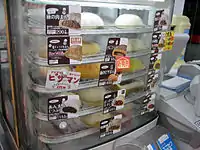
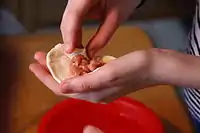
| English name/ Pīnyīn | Chinese name
Pinyin (Mandarin/Cantonese) |
Other names | Description |
|---|---|---|---|
| Cha siu bao, Charsiu bau | 叉燒包 chāshāobāo caa1 siu1 baau1 | manapua, Siopao | Filled with barbecue-flavoured char siu pork; typical of Cantonese cuisine (Guangdong province and Hong Kong) |
| Goubuli | 狗不理 gǒubùlǐ | a well known restaurant chain specializing in baozi considered characteristic of Tianjin, Northern China; Its name literally means, "Dog ignores it". | |
| Xiaolongbao | 小籠包 xiǎolóngbāo | a small, meat-filled baozi from Shanghai Containing a juicy broth. Because it is succulent and prepared only with thin, partially leavened dough, it is sometimes considered different from other bao types, and more closely resembles a jiaozi (dumpling) | |
| Shuijianbao | 水煎包 shuǐjiānbāo | Very similar to xiaolongbao, but pan-fried instead of steamed. | |
| Shengjian mantou | 生煎饅頭 shēngjiān mántou | A small, meat-filled, fried baozi from Shanghai | |
| Tangbaozi | 湯包 tāngbāo | a large soup-filled baozi from Yangzhou Drunk through a straw; in other areas of China, it is small in size with rich soup | |
| Doushabao | 豆沙包 dòushābāo | Hokkien: tāu-se-pau | Filled with sweet bean paste |
| Lotus seed bun | 蓮蓉包 liánróngbāo | Filled with sweetened lotus seed paste | |
| Kaya-baozi | 咖央包子 | Malay: pau kaya | filled with Kaya, a popular jam made from coconut, eggs, and sometimes pandan in Indonesia, Malaysia, and Singapore |
| Naihuangbao | 奶黃包 nǎihuángbāo | filled with sweet yellow custard filling | |
| Shāobāo, siopao | 燒包 shāobāo | Philippine: siyopaw | steamed, filled with either chicken, pork, shrimp or salted egg |
| Zhimabao | 芝麻包 zhīmabāo | steamed, filled with a black sesame paste | |
| Yacaibao (Beansprout-bao) | 芽菜包 Yácàibāo | steamed, filled with a type of pickle, spices and possibly other vegetables or meat, common in Sichuan, China | |
| Bah-pau | 肉包 ròubāo | Hokkien: bah-pau Indonesian: bakpau | filled with minced pork as well as chocolate, strawberry, cheese, mung bean, red bean, minced beef, or diced chicken. |
| Big Pau | 大包 dàbāo | large buns filled with pork, eggs and other ingredients | |
| Gua bao | 割包 guàbāo | 虎咬豬 hó͘-kā-ti | Originated as Fujianese street food. Unlike other types of Bao, Gua Bao is made by folding over the flat steamed dough and is thus open. Designed to fit easily in your hands and has a wide variety of fillings. |
| Crisp Stuffed Bun | 破酥包 poshubao | A lard-layered bun with pork, lard, bamboo shoot, and soy sauce; or with the filling of Yunnan ham and white sugar or brown sugar. Crisp Stuffed Bun was created by a chef from Yuxi almost a hundred years ago. | |
| Tandoori Baozi | 烤包子 Kao Baozi | Uyghur: سامسا самса Samsa | A Uyghur specialty, cooked in tandoor instead of steaming it. Usually filled with lamb, potatoes, and spices. |
Culture
In many Chinese cultures, these buns are a popular food, and widely available.[1] While they can be eaten at any meal, baozi are often eaten for breakfast. They are also popular as a portable snack or meal.
The dish has also become common place throughout various regions of north Asia with cultural and ethnic relationships, as well as Southeast Asia due to long standing Chinese immigration.
- In Buryatia and Mongolia, the variants of the recipe, often with beef or lamb, are known as buuz and buuza.[6][7]
- Due to the long history. Chinese overseas diaspora in Malaysia, the Malays have adopted these buns as their own bun. A particularly Malay form of the baozi (called pau in Malay) is filled with potato curry, chicken curry or beef curry that are similar to the fillings of Malay curry puffs. Some variants have a quail egg in the middle, in addition to the curry. Due to the Muslim beliefs of most Malays, these buns are halal and contain no pork. One can find Malay stalls selling the buns by the roadside, at pasar malams (night markets), highway rest stops, and pasar Ramadans (Ramadan food bazaars).
- Similarly, in Indonesia the dish has been adopted into Indonesian cuisine through the integration of Chinese culture. It has been adopted through the Hokkien name of bakpau. In addition to meat fillings, local variants include: chocolate, sweet potato, and marmalade filling.
- As a colonial influence from Indonesia, at supermarkets in the Netherlands one can easily find frozen bapao or bakpao wrapped in plastic, ready-made to be heated inside a microwave. The most prevalent filling is chicken, although there are pork and beef variants available as well. This food is culturally categorized as a quick snack or a fast-food item. Fresh forms of this steamed bun are not seen outside of the Chinese community within the country.
- In the Philippines, their version of baozi is called siopao brought by Chinese immigrants (Sangleys) prior to Spanish colonialism. A Filipino siopao filling contains meatballs, Philippine adobo, flaked tuna and pork, and sometimes chocolate and cheese.
- A similar concept is also present in Thailand, called salapao.
- Baozi is also very popular in Japan where it's known as nikuman and is typically sold in convenience stores.
- Baozi is called num bao in Cambodian. It is a popular snack in Cambodia and is usually homemade or sold in street markets.
- Bánh bao is the Vietnamese version of the Cantonese tai bao that was brought over by Chinese immigrants.
- The Myanmar version is called "pauk-si" (ပေါက်စီ)[8][9] and is a popular snack available in almost every traditional tea shops.
See also
References
- Phillips, C. (2016). All Under Heaven: Recipes from the 35 Cuisines of China. Ten Speed Press. p. 405. ISBN 978-1-60774-982-0. Retrieved November 5, 2016.
- "Shǐ huà " mán tóu " hé " bāo zǐ " yóu lái" 史話“饅頭”和“包子”由來 (in Chinese).
- 王栐(北宋). 燕翼冶谋录.
“仁宗诞日,赐群臣包子。”包子下注“即馒头别名。”、“今俗屑发酵,或有馅,或无馅,蒸食之者,都谓之馒头。”
- cf Zhuge Liang tale; also "Shǐ huà " mán tóu " hé " bāo zǐ " yóu lái" 史話“饅頭”和“包子”由來 (in Chinese).
- 周达观(元). 诚斋杂记.
孔明征孟获。人曰:蛮地多邪,用人首祭神,则出兵利。孔明杂以羊豕之内,以面包之,以像人头。此为馒头之始。
- Mezhenina, Tatiana. "Close-up buryat, mongolian or chinese traditional buuz, buuza,." 123RF. Retrieved 2021-01-13.
(image) Close-up of buryat, mongolian or chinese traditional buuz, buuza, baozi. Asian steamed food made of dough and meat.
- Getty. "Close-Up Of chinese origin meat dumplings, aka buuz or buzza or..." Getty Images. Retrieved 2021-01-13.
Close-Up of chinese origin meat dumplings, aka buuz or buzza or manti, a popular dish in Buryatia Republic (Russia) and russian Siberia regions or among Central Asian countries.
- ": ပေါက်စီ". Sofia Food Paradise. December 23, 2015.
- "ဝက်သားပေါက်စီအိအိလေး". Wutyee Food House.

